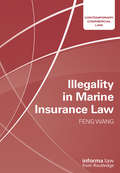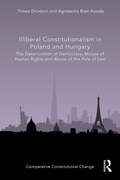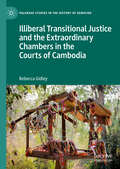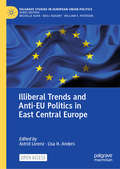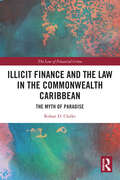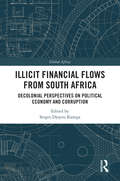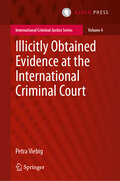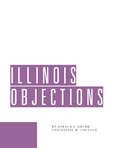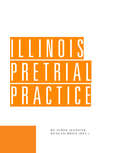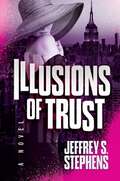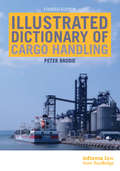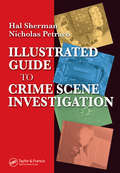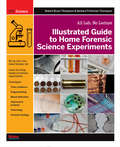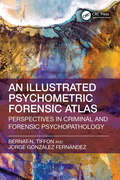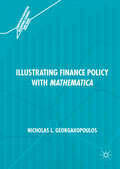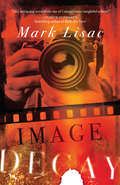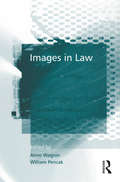- Table View
- List View
Illegality in Marine Insurance Law (Contemporary Commercial Law)
by Feng WangIllegality in Marine Insurance Law is the first book to deal specifically with illegality in the context of marine insurance law. Previously, this issue has only ever been partially covered within analysis and criticism of Section 41 of the Marine Insurance Act 1906 and warranties. However, Dr Wang Feng goes much further than this by considering its impact on the common law relevant to marine insurance in many jurisdictions worldwide. The book addresses whether the existing law represents an accurate codification of the former authorities and whether Section 41 truly reflects existing legal principles. As well as this, the book examines how correctly to approach illegality within the context of marine insurance, considering the fundamental changes to the rule of breach of warranty introduced by the Insurance Act 2015. Of interest to academic researchers and practitioners in common law and civil law jurisdictions, this book provides rigorous analysis of the illegality issue and a conceptual approach for various approaches to reform marine insurance law. It is a unique and comprehensive guide to illegality in marine insurance law.
Illegality in Marine Insurance Law (Contemporary Commercial Law)
by Feng WangIllegality in Marine Insurance Law is the first book to deal specifically with illegality in the context of marine insurance law. Previously, this issue has only ever been partially covered within analysis and criticism of Section 41 of the Marine Insurance Act 1906 and warranties. However, Dr Wang Feng goes much further than this by considering its impact on the common law relevant to marine insurance in many jurisdictions worldwide. The book addresses whether the existing law represents an accurate codification of the former authorities and whether Section 41 truly reflects existing legal principles. As well as this, the book examines how correctly to approach illegality within the context of marine insurance, considering the fundamental changes to the rule of breach of warranty introduced by the Insurance Act 2015.Of interest to academic researchers and practitioners in common law and civil law jurisdictions, this book provides rigorous analysis of the illegality issue and a conceptual approach for various approaches to reform marine insurance law. It is a unique and comprehensive guide to illegality in marine insurance law.
Illiberal Constitutionalism in Poland and Hungary: The Deterioration of Democracy, Misuse of Human Rights and Abuse of the Rule of Law (Comparative Constitutional Change)
by Tímea Drinóczi Agnieszka Bień-KacałaThis book theorizes illiberal constitutionalism by interrogation of the Rule of Law, democratic deterioration, and the misuse of the language and relativization of human rights protection, and its widespread emotional and value-oriented effect on the population. The work consists of seven Parts. Part I outlines the volume’s ambitions and provides an introduction. Part II discusses the theoretical framework and clarifies the terminology adopted in the book. Part III provides an in-depth insight into the constitutional identity of Poles and Hungarians and argues that an unbalanced constitutional identity has been moulded throughout Polish and Hungarian history in which emotional traits of collective victimhood and collective narcissism, and a longing for a charismatic leader have been evident. Part IV focuses on the emergence of illiberal constitutionalism, and, based on both quantitative and qualitative analyses, argues that illiberal constitutionalism is neither modern authoritarianism nor authoritarian constitutionalism. This Part contextualizes the issue by putting the deterioration of the Rule of Law into a European perspective. Part V explores the legal nature of illiberal legality when it is at odds and in compliance with the European Rule of Law, illiberal democracy, focusing on electoral democracy and legislative processes, and illiberalization of human rights. Part VI investigates whether there is a clear pattern in the methods of remodeling, or distancing from constitutional democracy, how it started, consolidated, and how its results are maintained. The final Part presents the author’s conclusions and looks to the future. The book will be an invaluable resource for scholars, academics and policy-makers interested in Constitutional Law and Politics.
Illiberal Transitional Justice and the Extraordinary Chambers in the Courts of Cambodia (Palgrave Studies in the History of Genocide)
by Rebecca GidleyThis book examines the creation and operation of the Extraordinary Chambers in the Courts of Cambodia (ECCC), which is a hybrid domestic/international tribunal tasked with putting senior leaders of the Khmer Rouge on trial. It argues that the ECCC should be considered an example of illiberal transitional justice, where the language of procedure is strongly adhered to but political considerations often rule in reality. The Cambodian government spent nearly two decades addressing the Khmer Rouge past, and shaping its preferred narrative, before the involvement of the United Nations. It was a further six years of negotiations between the Cambodian government and the United Nations that determined the unique hybrid structure of the ECCC. Over more than a decade in operation, and with three people convicted, the ECCC has not contributed to the positive goals expected of transitional justice mechanisms. Through the Cambodian example, this book challenges existing assumptions and analyses of transitional justice to create a more nuanced understanding of how and why transitional justice mechanisms are employed.
Illiberal Trends and Anti-EU Politics in East Central Europe (Palgrave Studies in European Union Politics)
by Astrid Lorenz Lisa H. AndersThis open access book provides an in-depth look into the background of rule of law problems and the open defiance of EU law in East Central European countries. Current illiberal trends and anti-EU politics have the potential to undermine mutual trust between member states and fundamentally change the EU. It is therefore crucial to understand their domestic causes, context conditions, specific processes and consequences. This volume contributes to empirically informed theory-building and includes contributions from researchers from various disciplines and multiple perspectives on illiberal trends and anti-EU politics in the region. The qualitative case studies, comparative works and quantitative analyses provide a comprehensive picture of current societal, political and institutional developments in the Czech Republic, Hungary, Poland and Slovakia. Through studying similarities and differences between East Central European and other EU countries, the chapters also explore whether there are regional patterns of democracy- and EU-related problems.
Illicit
by Moises NaimA groundbreaking investigation of how illicit commerce is changing the world by transforming economies, reshaping politics, and capturing governments.In this fascinating and comprehensive examination of the underside of globalization, Moises Naím illuminates the struggle between traffickers and the hamstrung bureaucracies trying to control them. From illegal migrants to drugs to weapons to laundered money to counterfeit goods, the black market produces enormous profits that are reinvested to create new businesses, enable terrorists, and even to take over governments. Naím reveals the inner workings of these amazingly efficient international organizations and shows why it is so hard -- and so necessary to contain them. Riveting and deeply informed, Illicit will change how you see the world around you.From the Trade Paperback edition.even take over governments. From pirated movies to weapons of mass destruction, from human organs to endangered species, drugs or stolen art, Illicit reveals the inner workings of these amazingly efficient international organizations and shows why it is so hard--and so necessary--to contain them.Illicit offers a fresh, ingenious and compelling vision of this untold story of globalization. It provides a powerful new lens with which to assess how today's world really works and where it may be headed. Illicit will surely ignite urgent debate at the highest levels--and change the way you think about the world.From the Hardcover edition.
Illicit Finance and the Law in the Commonwealth Caribbean: The Myth of Paradise (The Law of Financial Crime)
by Rohan D. ClarkeThis book provokes fresh ways of thinking about small developing States within the transnational legal order for combating money laundering and the financing of terrorism and proliferation (TAMLO). From the global wars on drugs and terror to journalistic exposés such as the ‘Paradise’, ‘Panama’ and ‘Pandora’ Papers, the Commonwealth Caribbean has been discursively stigmatised as a mythical island paradise of ‘rogue’ States. Not infrequently, their exercise of regulatory self-determination has been presented as the selling of their economic sovereignty to facilitate shady business deals and illicit finance from high-net-worth individuals, kleptocrats, tax-dodgers, organised crime networks and terrorist financiers. This book challenges conventional wisdom that Commonwealth Caribbean States are among the ‘weakest links’ within the global ecosystem to counter illicit finance. It achieves this by unmasking latent interests, and problematising coercive extraterritorial regulatory and surveillance practices, along the onshore/offshore and Global North/South axes. Interdisciplinary in its outlook, the book will appeal to policymakers, regulatory and supervisory authorities, academics and students concerned with better understanding legal and development policy issues related to risk-based regulatory governance of illicit finance as well as those arising from money laundering related to corruption, politically exposed persons (PEPs), offshore finance and offshore Internet gambling services.
Illicit Financial Flows from South Africa: Decolonial Perspectives on Political Economy and Corruption (Global Africa)
by Serges Djoyou KamgaThis book examines the detrimental impact of illicit financial flows on South Africa’s development, political economy, and transformation in the 21st century. Over the years, illicit financial flows have led to the systematic looting and channelling away of South African resources, yet they are rarely studied by researchers looking to explain the country’s underdevelopment and political economy. This book looks across sectors, showing that illicit financial flows cut across all the key pillars of development, frustrating the betterment of peoples’ lives in South Africa. Investigating the problem from a decolonial perspective, the book delves deep into the catastrophic impacts of illicit financial flows for people and the economy, discusses how the problem is being combatted, and ultimately suggests solutions for rebuilding social trust between people and the state. Making an important contribution to the decolonial debate, as well as to discussions of South Africa’s political economy, this book will be of interest to researchers across African studies, global development, political science, law and corruption studies.
Illicitly Obtained Evidence at the International Criminal Court
by Petra ViebigThis work deals with the exclusion of illicitly obtained evidence at the International Criminal Court. At the level of domestic law, the so-called exclusionary rule has always been a very prominent topic. The reason for this is that the way a court of law deals with tainted evidence pertains to a key aspect of procedural fairness. It concerns the balancing of the right to a fair trial with the interest of society in effective law enforcement. At the international level, however, the subject has not yet been discussed in detail. The present research intends to fill this gap. It provides an overview of the approaches of a number of domestic legal systems as well as of the approaches of the UN ad hoc tribunals and the European Court of Human Rights and uses the different perspectives to develop a version of the exclusionary rule which fits the International Criminal Court. The book is highly recommended for practitioners and researchers in the field of international criminal law and especially the law of international criminal evidence. Petra Viebig is a Public Prosecutor at the Staatsanwaltschaft Hamburg, Germany.
Illicitly Obtained Evidence at the International Criminal Court (International Criminal Justice Series #4)
by Petra ViebigThis work deals with the exclusion of illicitly obtained evidence at the International Criminal Court. At the level of domestic law, the so-called exclusionary rule has always been a very prominent topic. The reason for this is that the way a court of law deals with tainted evidence pertains to a key aspect of procedural fairness. It concerns the balancing of the right to a fair trial with the interest of society in effective law enforcement. At the international level, however, the subject has not yet been discussed in detail. The present research intends to fill this gap. It provides an overview of the approaches of a number of domestic legal systems as well as of the approaches of the UN ad hoc tribunals and the European Court of Human Rights and uses the different perspectives to develop a version of the exclusionary rule which fits the International Criminal Court. The book is highly recommended for practitioners and researchers in the field of international criminal law and especially the law of international criminal evidence. Petra Viebig is a Public Prosecutor at the Staatsanwaltschaft Hamburg, Germany.
Illinois Criminal and Traffic Law Manual (2015 Edition)
by Lexisnexis StaffIllinois Criminal and Traffic Law Manual 2015 Edition
Illinois Objections
by Gerald Grubb Daniel LocalloObjections, Responses, Arguments, Tips and Cases Most evidentiary rulings are within the judge's discretion, and are made in seconds. Bad rulings are almost never reversible. As a result, victory usually goes to the lawyer who can prevail on the big objections in the heat of battle. The key to winning evidentiary debates is objecting and responding with arguments and supporting authority at your fingertips. That is where Judges Daniel M. Locallo and Gerald F. Grubb's Illinois Objections comes in. It uses a courtroom-friendly format to cover over 130 objections with clear and concise explanations, trial-tested tips, persuasive arguments, and supporting cases. 2,000 Recent Cases Illinois Objections provides a time-saving alternative to lengthy treatises. Its concise but well-supported text puts the rules and cases at your fingertips. And its practical orientation guides you through the realities of evidentiary battles. Covers All Important Objections Illinois Objections is more than an evidence book. In addition to evidentiary objections, you'll find objections to jury selection, opening statement, closing argument, jury charges, judicial conduct and more. Coverage of all significant trial objections--from jury selection through closing argument--gives Illinois Objections vastly greater practical value than an evidence-only book. Delivers More than Objections The scope and breadth of Illinois Objections far exceeds the mechanics and arguments of making and meeting objections. Rules, definitions, distinctions, scope, weight, advice from the bench, examples, and procedures are provided for key evidentiary issues. Principles are extensively supported with case authority, and the underlying scholarship will impress you. Don't let opposing counsel's objections block the admission of your critical evidence. And don't be caught unprepared when opposing counsel offers evidence you could obstruct--if you made the proper objection. Now you can more readily: Preclude trial objections through motions in limine Evaluate the admissibility of the opposition's evidence Preserve the record for appeal Decide when to object and when to remain silent From pretrial proceedings through expert testimony to summation, the practical coverage in this trial practice book will quickly earn its inexpensive keep.
Illinois Pretrial Practice: Revision 11
by Jennifer Duncan-BriceAnswers, Tips and Forms for Illinois Litigators As court interpretations evolve and laws change, it is crucial to stay informed. For Illinois litigators, that's where Illinois Pretrial Practice comes in handy. The 2014 update of Illinois Pretrial Practice contains dozens of new cases, 9 new sections, and an entirely new chapter about interlocutory appeals. This year's edition includes discussions of the following: Circumstances under which the interlocutory appeal is allowed, as well as the procedure to obtain an interlocutory appeal Governmental immunities available to defendants which are not commonly known, such as the "officer suit" exception Dramatic changes to Illinois' Freedom of Information Act statute that have made it much more user-friendly Other changes to Illinois law, including a recent court decision holding that a public accounting privilege belongs to the person hiring the accountant. Written by retired circuit court judge Jennifer Duncan-Brice, Illinois Pretrial Practice delivers quick and reliable answers with its unique outline format, tight writing, superb scholarship, and extensive citations. In addition, this helpful guide contains practice-tested forms and pattern paragraphs designed to speed drafting. Illinois Pretrial Practice delivers quick and reliable answers with its unique outline format, tight writing, superb scholarship, and extensive citations. Its practice-tested forms and pattern paragraphs speed drafting. This book concentrates on the topics where questions and disputes arise. It devotes pages where you spend time: drafting pleadings, preparing and presenting motions, conducting discovery, resolving discovery disputes, and negotiating settlements. You will find coverage of troublesome matters like: Written Discovery Privileges Motions Illinois Pretrial Practice provides authoritative and direct responses to everyday discovery issues like these: Paper discovery Depositions Other issues The book's issue-oriented outline format is supported by more than 2,000 citations, more than 125 forms, advice from the bench, recent case-based illustrations, practice-proven strategies, step-by-step procedures, pattern language, and Digital Access to forms. Coverage runs from taking the case up to trial, and includes numerous tips.
Illusion of Justice: Inside Making a Murderer and America's Broken System
by Jerome F. Buting“A compelling portrait of the mechanisms of building a murder defense. A fantastic look behind the scenes of the U.S. justice system.” —Kirkus ReviewsOver his career, Jerome F. Buting has spent hundreds of hours in courtrooms representing defendants in criminal trials. When he agreed to join Dean Strang as co-counsel for the defense in Steven A. Avery vs. State of Wisconsin, he knew a tough fight lay ahead. But, as he reveals in Illusion of Justice, no-one could have predicted just how twisted that fight would be—or that it would become the center of the documentary Making a Murderer, which made Steven Avery and Brendan Dassey household names.Buting’s powerful, riveting boots-on-the-ground narrative of Avery’s and Dassey’s cases becomes a springboard to examine the shaky integrity of law enforcement and justice in the United States, which Buting has witnessed firsthand for more than thirty-five years. From his early career as a public defender to his success overturning wrongful convictions working with the Innocence Project, his story provides an insider view into the high-stakes arena of criminal defense law; the difficulties of forensic science; and a horrifying reality of biased interrogations, coerced or false confessions, faulty eyewitness testimony, official misconduct, and more.Combining narrative reportage with critical commentary and personal reflection, Buting explores his professional and personal motivations, career-defining cases, and what must happen if our broken system is to be saved. Illusion of Justice is a tour-de-force from a relentless and eloquent advocate for justice who is determined, in the face of overwhelming odds, to make America’s judicial system work as it is designed to do.
Illusions of Trust
by Jeffrey S. StephensWhen attorney Russell Palmer agreed to handle the divorce of a beautiful and wealthy socialite, he never anticipated the tangled web of deceit, corruption—and murder—he would be forced to confront.Russell Palmer, a young New York City attorney, is well-known for taking on unusual and high-risk cases alongside his private detective associate, Robbie Whyte. When the wealthy and alluring Christina Franco approaches him to represent her during divorce proceedings, he finds her story impossible to resist. As Christina recounts the abuse she has suffered, Palmer&’s protective instincts kick in. His interest deepens when she mentions a dangerous associate of her husband—someone Palmer has clashed with before. Soon, a series of events begins to unfold that may or may not be related to Christina and her influential family. There is the apparent suicide of a prominent lawyer. That is followed by a murder for which another of Palmer&’s clients is charged. Then, a federal investigation into a major pharmaceutical company is tied to Christina&’s husband. As Palmer and Whyte work to solve an increasingly complex puzzle, they follow a trail that leads them from New York&’s underground to the rarified world of the ultra-rich—and even into the halls of Congress. Along the way they encounter a cast of intriguing individuals, including Christina&’s parents—an influential politician and his reclusive wife; an attractive journalist with a personal interest in Palmer; and a number of others populating their client&’s world. As they peel back layers of deceit and corruption at every turn, Palmer and Whyte must navigate a treacherous path to protect their clients—and themselves—while ensuring that justice, in all its forms, prevails.
Illustrated Dictionary of Cargo Handling
by Peter BrodieNow in its fourth edition, this illustrated dictionary gives readers a visual representation of all elements of maritime transport which relate to the handling and movement of cargo. This is particularly for the benefit of shore-based personnel who often do not get the opportunity to see first-hand how the cargoes they are working on are handled and moved. The book covers: every major commodity how it is loaded how it is discharged what equipment is used to handle and store it any specialised terminal required This new edition not only includes many new definitions, it also benefits from several photographic sequences showing cargo loading and discharging processes in action from start to finish. This book is a valuable reference to any professionals working in the shipping and cargo handling industry.
Illustrated Guide to Crlme Scene Investigation
by Nicholas Petraco Hal ShermanYou are the first to arrive at the scene. You secure the area, and record what the human eye can see so far. You begin your search. You come across what appears to be physical evidence, and proceed to carefully document, package, and transport it to the lab. You fill out the routine paperwork, and feel secure in the knowledge that you have done eve
Illustrated Guide to Home Forensic Science Experiments: All Lab, No Lecture
by Robert Bruce Thompson Barbara Fritchman ThompsonHave you ever wondered whether the forensic science you’ve seen on TV is anything like the real thing? There’s no better way to find out than to roll up your sleeves and do it yourself. This full-color book offers advice for setting up an inexpensive home lab, and includes more than 50 hands-on lab sessions that deal with forensic science experiments in biology, chemistry, and physics. You’ll learn the practical skills and fundamental knowledge needed to pursue forensics as a lifelong hobby—or even a career.The forensic science procedures in this book are not merely educational, they’re the real deal. Each chapter includes one or more lab sessions devoted to a particular topic. You’ll find a complete list of equipment and chemicals you need for each session.Analyze soil, hair, and fibersMatch glass and plastic specimensDevelop latent fingerprints and reveal blood tracesConduct drug and toxicology testsAnalyze gunshot and explosives residuesDetect forgeries and fakesAnalyze impressions, such as tool marks and footprintsMatch pollen and diatom samplesExtract, isolate, and visualize DNA samplesThrough their company, The Home Scientist, LLC (thehomescientist.com/forensics), the authors also offer inexpensive custom kits that provide specialized equipment and supplies you’ll need to complete the experiments. Add a microscope and some common household items and you’re good to go.
Illustrated Psychometric Forensic Atlas: Perspectives in Criminal and Forensic Psychopathology
by Bernat-N. Tiffon Jorge Gonzalez FernandezOriginally published in Spanish in 2022 by Libreria Bosch, Barcelona, An Illustrated Psychometric Forensic Atlas is a one-of-a-kind book made available in English for the first time. This unique work is highly illustrated with full-color images, providing medico-legal examinations related to various, primarily violent, crime cases, which are of forensic psychological interest.The book provides extensive details of such cases, including the background circumstances, psychological assessments and – in some cases – official clinical diagnoses, as well as numerous photos that illustrate what police, investigators and medical examiners discovered during crime scene and autopsy inquiries. While the coverage largely focuses on the details surrounding these cases, the book articulates the capabilities of forensic and psychology professionals and expert witnesses in such cases, as well as the limitations based on what information is unknown and, in some cases, cannot be known. This largely pertains to the psychological state of the aggressors and perpetrators in such violent cases and acts. The result is a thoroughly engaging presentation of forensically challenging cases; the investigative and assessment processes performed by medical, forensic, investigative and psychological professionals and a critical understanding of how the procedures followed impact the adjudication of such cases in the courts. While some cases can be definitively understood, with the results determined through forensic and psychological analyses, others leave many important questions unresolved and unanswered. As such, the book provides a fascinating analysis – and sheds light on – practices that can inform these types of cases, as well as the constraints of what forensic and psychological analysis can yield.
Illustrating Finance Policy with Mathematica (Quantitative Perspectives On Behavioral Economics And Finance Ser.)
by Nicholas L. GeorgakopoulosStudents in various disciplines—from law and government to business and health policy—need to understand several quantitative aspects of finance (such as the capital asset pricing model or financial options) and policy analysis (e.g., assessing the weight of probabilistic evidence) but often have little quantitative background. This book illustrates those phenomena and explains how to illustrate them using the powerful visuals that computing can produce. Of particular interest to graduate students and scholars in need of sharper quantitative methods, this book introduces the reader to Mathematica, enables readers to use Mathematica to produce their own illustrations, and places specific emphasis on finance and policy as well as the foundations of probability theory.
Ilse Koch on Trial: Making the “Bitch of Buchenwald”
by Tomaz JardimAn authoritative reassessment of one of the Third Reich’s most notorious war criminals, whose alleged sexual barbarism made her a convenient scapegoat and obscured the true nature of Nazi terror.On September 1, 1967, one of the Third Reich’s most infamous figures hanged herself in her cell after nearly twenty-four years in prison. Known as the “Bitch of Buchenwald,” Ilse Koch was singularly notorious, having been accused of owning lampshades fabricated from skins of murdered camp inmates and engaging in “bestial” sexual behavior. These allegations fueled a public fascination that turned Koch into a household name and the foremost symbol of Nazi savagery. Her subsequent prosecution resulted in a scandal that prompted US Senate hearings and even the intervention of President Truman.Yet the most sensational atrocities attributed to Koch were apocryphal or unproven. In this authoritative reappraisal, Tomaz Jardim shows that, while Koch was guilty of heinous crimes, she also became a scapegoat for postwar Germans eager to distance themselves from the Nazi past. The popular condemnation of Koch—and the particularly perverse crimes attributed to her by prosecutors, the media, and the public at large—diverted attention from the far more consequential but less sensational complicity of millions of ordinary Germans in the Third Reich’s crimes.Ilse Koch on Trial reveals how gendered perceptions of violence and culpability drove Koch’s zealous prosecution at a time when male Nazi perpetrators responsible for greater crimes often escaped punishment or received lighter sentences. Both in the international press and during her three criminal trials, Koch was condemned for her violation of accepted gender norms and “good womanly behavior.” Koch’s “sexual barbarism,” though treated as an emblem of the Third Reich’s depravity, ultimately obscured the bureaucratized terror of the Nazi state and hampered understanding of the Holocaust.
Image Analysis and Recognition: 15th International Conference, ICIAR 2018, Póvoa de Varzim, Portugal, June 27–29, 2018, Proceedings (Lecture Notes in Computer Science #10882)
by Aurélio Campilho Fakhri Karray Bart ter Haar RomenyThis book constitutes the thoroughly refereed proceedings of the 15th International Conference on Image Analysis and Recognition, ICIAR 2018, held in Póvoa de Varzim, Portugal, in June 2018.The 91 full papers presented together with 15 short papers were carefully reviewed and selected from 179 submissions. The papers are organized in the following topical sections: Enhancement, Restoration and Reconstruction, Image Segmentation, Detection, Classication and Recognition, Indexing and Retrieval, Computer Vision, Activity Recognition, Traffic and Surveillance, Applications, Biomedical Image Analysis, Diagnosis and Screening of Ophthalmic Diseases, and Challenge on Breast Cancer Histology Images.
Image Decay
by Mark LisacMark Lisac’s Image Decay returns to the pugnacious world of backroom politics laid out in his award-nominated Where the Bodies Lie. Set again in that “unnamed capital city east of the Rockies,” where the Brutalist architecture of the downtown core reflects the body politic laid bare.When a cantankerous ex-government photographer seeks ownership of his prints, the powers-that-be are determined to prevent the release of certain sensitive photos. Set in the 1990s, this political thriller delves into questions of identity and memory, established power and its fears and secrets, old stock versus newcomers, belonging and alienation.Image Decay investigates the intricacies of political manipulation, personal anxieties, and how history must be seen to be confronted.
Image Reconstruction in Radiology
by J. A. ParkerThis one-of-a-kind resource provides a very readable description of the methods used for image reconstruction in magnetic resonance imaging, X-ray computed tomography, and single photon emission computed tomography. The goal of this fascinating work is to provide radiologists with a practical introduction to mathematical methods so that they may better understand the potentials and limitations of the images used to make diagnoses. Presented in four parts, this state-of-the-art text covers (1) an introduction to the models used in reconstruction, (2) an explanation of the Fourier transform, (3) a brief description of filtering, and (4) the application of these methods to reconstruction. In order to provide a better understanding of the reconstruction process, this comprehensive volume draws analogies between several different reconstruction methods. This informative reference is an absolute must for all radiology residents, as well as graduate students and professionals in the fields of physics, nuclear medicine, and computer-assisted tomography.
Images in Law
by William PencakWhat does 'the law' look like? While numerous attempts have been made to examine law and legal action in terms of its language, little has yet been written that considers how visual images of the law influence its interpretation and execution in ways not discernible from written texts. This groundbreaking collection focuses on images in law, featuring contributions that show and discuss the perception of the legal universe on a theoretical basis or when dealing with visual semiotics (dress, ceremony, technology, etc.). It also examines 'language in action', analyzing jury instructions, police directives, and how imagery is used in conjunction with contentious social and political issues within a country, such as the image of family in Ireland or the image of racism in France.
